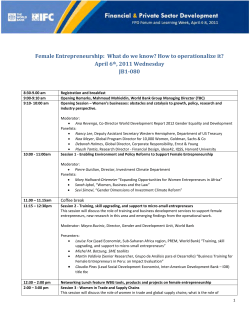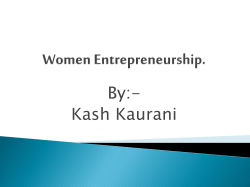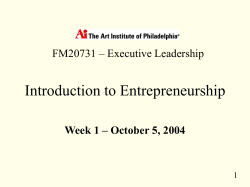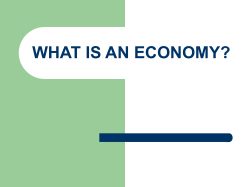
International Journal of Advance Research in
ISSN: 23217782 (Online) Volume 3, Issue 2, February 2015 International Journal of Advance Research in Computer Science and Management Studies Research Article / Survey Paper / Case Study Available online at: www.ijarcsms.com Women Entrepreneurship in the Rural Environment Smitha S.S1 Dr. Rama Krishna G.S2 Asst. Prof., Dept. of Mgt. Studies, Sri Y.N. College, Narsapur – 534 275, W.G.Dt., Andhra Pradesh, India. Associate Prof., Dept. of Mgt. Studies, Sri Y.N. College, Narsapur – 534 275, W.G.Dt., Andhra Pradesh, India. Samuel Mores G3 Asst. Prof., Dept. of Mgt. Studies, Sri Y.N. College, Narsapur – 534 275, W.G.Dt., Andhra Pradesh, India. Abstract: Women constitute around half of the world’s population. Hence, they can rightly be regarded as the “better half of the society". People living in rural peripheries especially women are illiterate and shoulder the burden of the world’s poverty. The productive potentiality of these rural women is indispensable to achieve the resilient economic growth. Reducing urban-rural and gender inequalities is essential for combating the problems like poverty, unemployment and helps in generating income source. Rural women are the major neglected sector. Developing rural women entrepreneurship is the need of the hour which can helps to overcome the problems of unemployment and poverty. It increases self employment and reduces unemployment, under employment and disguised employment. Rather than push factors, pull factors should influence the rural women to start their own business of their interest which brings a qualitative change. For this they require adequate education, awareness, motivation, support and encouragement to avail the market opportunities with their inherent potentiality, initiative, creativity, commitment, risk-taking ability, dedication and devotion towards the work as their basic investments. Only by the joint efforts of both men and women in this concern can bring a healthy change which helps the country to develop with in no time. Keywords: Self Help Groups, Rural women entrepreneur, Women empowerment, risk-taking ability, creativity, commitment I. INTRODUCTION Women represent 50 percent of the world population but they are receiving only 10 percent of the world income and 1 percent of world’s assets. Women and girls constitute three-fifth of the world’s poor. Their poverty level is worse than that of men as clear gender disparities in education, employment opportunities and decision making power exist. So it is clear that people living in rural peripheries, especially women, shoulder the burden of the world’s poverty. They have been deprived for too long from participating in the opportunities and benefits of economic growth and globalization. Rural entrepreneurship is considered as one of the most important factors contributing to the economic development of the rural society. Promotion of entrepreneurship among rural women is a major step to increase women participation in rural and economic development. Rural entrepreneurship is today a buzzword in the changing rural economy. It is a purposeful activity initiating, promoting and maintaining economic growth. Rural entrepreneurship is not new to our culture. What it needs today is to nurture this spirit and instill it in the present and coming generations of both men and women. It is said that if a man starts a business venture he only becomes the entrepreneur, while when a women takes to entrepreneurship the whole family becomes entrepreneurial in its behaviour and outlook. Therefore, if women gain economic strength, they gain visibility and voice. With the economic restructuring and societal acceptance in the modern days, women have started establishing and running enterprises successfully. Though women entrepreneurship is in its infancy and transition period, it is all set to go a long way. © 2015, IJARCSMS All Rights Reserved 138 | P a g e Smitha et al., International Journal of Advance Research in Computer Science and Management Studies Volume 3, Issue 2, February 2015 pg. 138-143 Today rural women entrepreneurs represent a group of women who have broken away from the beaten track and are exploring new avenues of rural and economic development. The number of women entrepreneurs have grown over a period of time and it is clear that the percentage is increasing every year. The present article endeavours to study the role of rural women entrepreneurs in the contribution towards the overall growth of the country. It also studies the bottlenecks for their growth and also offers some suggestions for the development of rural women entrepreneurs and overall development. a) Driving Forces for Women Entrepreneurs: » To attain economic independence. » To establish their own creativity. » To establishing their own identity. » To achieve excellence. » To developing risk-taking ability. » To attain equal status in society. » To have greater freedom and mobility. » To earn additional income to the family. » To achieve women empowerment. » To make use of unutilized and underutilized local resources. II. INDIAN PERSPECTIVE India has the world’s largest number of professionally qualified women. It has more female doctors, surgeons, scientists and professors than in U.S. It also has successful women entrepreneurs. India has more working women than any other country in the world. But, the women who are highly qualified, skilled, take-up good jobs and are very successful as entrepreneurs are confined to urban areas and their contribution towards the generation of National income and economic growth is not adequate. In India the rural area contributes to 72 percent and among that 50 percent are women, who are not having adequate opportunities to educate, develop, get good opportunities or start their own business by which they can stand on their own feet. Thus they are not given an opportunity to contribute for national income, growth and development. In India we face the problems of unemployment, disguised employment, under employment and poverty. Rural women entrepreneurship can be a good answer to all these problems as it not only provides employment and source of income to the major neglected sector of the country but also to all those who become associated with the business concern. a) Government Initiatives: The Government of India has been encouraging self-employment and has started several schemes to promote entrepreneurship among women. Various income generating schemes like Support to Training and Employment Programme (STEP), Swavalambana Socio-Economic Programme, Pradhan Mantri Gram Swarozgar Yojana, Pradhan Mantri Shahri Swarozgar Yojana, Jana Shikshan Sansthan (JSS) etc. have been launched to this end. Women are encouraged to organize and form Self Help Groups (SHGs) and Cooperatives which undertake activities to generate income for the most vulnerable groups of women. Rastriya Mahila Kosh (RMK) was set up to provide loans to these women who could then become self employed by establishing their own business or small scale enterprises. Women’s Development Corporations, operating in a few States in © 2015, IJARCSMS All Rights Reserved ISSN: 2321‐7782 (Online) 139 | P a g e Smitha et al., International Journal of Advance Research in Computer Science and Management Studies Volume 3, Issue 2, February 2015 pg. 138-143 India are promoting entrepreneurship among women at the gross root level. In this way, women at the grassroots and other levels, who are managing small-scale industries and enterprises, are becoming economically empowered. III. BOTTLENECKS FOR THE DEVELOPMENT OF WOMEN ENTREPRENEURS Inspite of their important contribution to socio-economic development, women suffer from various constraints, which inhibit them from fully realizing their potential for development. Some of the reasons are as below: » Rural women are unaware of the legal provisions and legislative systems that help them to take initiative and avail opportunities to become entrepreneurs. Their understandings as well as their capacity to identify unjustified application of the regulation are weak. » Increase in the crime rate and lack of security to women is also not permitting them to come out and participate in the business activities at par with men. » Complex regulatory requirements and lengthy licensing process and costly operations often discourage rural women to start a business. » Furthermore, their reproductive role in family and the community puts women in a disadvantaged position to engage in entrepreneurial activities. » Cultural values and social norms hinder the equal participation of women in the society. » One of the major constraints women face as entrepreneurs is the unequal access to productive resources and services, including finance and skill upgrading opportunities. Some other problems which our rural women entrepreneurs face today are: » Small investment. » Tough competition. » Lack of awareness of marketing techniques. » Lack of women entrepreneur role models in rural areas. » Business not in the area of interest. » Lack of confidence. » Lack of motivation. » Lack of family support. » Inability to dream. » Negative self perception. » Lack of computer knowledge and access to internet. a) Measures to remove the bottlenecks and come over the problems: » Women human resource should develop in such a way to increase their competitive entrepreneurship, technology absorbing capacities and control over asset management. » To respond to the needs of women to materialize their economic potential and thereby to improve their standard of living, it is necessary to design programmes by applying mainstreaming strategy. © 2015, IJARCSMS All Rights Reserved ISSN: 2321‐7782 (Online) 140 | P a g e Smitha et al., » International Journal of Advance Research in Computer Science and Management Studies Volume 3, Issue 2, February 2015 pg. 138-143 Necessary measures have to be devised to integrate women as decision-makers, participants and beneficiaries in all relevant development activities, irrespective of the sector or type of activity. » It is also necessary to address the totality of problems rural woman face as entrepreneurs, due to wide spectrum of elements effecting the equitable participation in development. » A bottom-up growth strategy has to be planned which focuses on the transformation and diversification of micro and small scale enterprises run by rural women to growth-oriented activities and on increasing the productive capacity in order to enable them to participate in the main stream economy of the nation. » A plan or strategy must be designed and implemented in close collaboration with various development partners in different specialized areas, notably education, health, human rights as well as environment and energy. » By organising themselves in groups and associations, rural women entrepreneurs can voice their specific concerns and advocate change through formal policy making process. This entrepreneurial group capacity helps to plan and implement common projects and keep motivation going. They can establish common projects such as: » » Collective marketing. » Bulk purchasing. » Group lending and group oriented enterprises. » Common facilities like sharing machines and equipment, a warehouse or a vehicle or office furniture. Top level and successful women entrepreneurs in urban areas and country wide should help, involve and encourage rural women entrepreneurs in mainstreaming their activities at national level. For example; women involved in textile and garments business in urban areas and well developed areas can give orders in bulk to rural women entrepreneurs involved in crochet lace business and saree embroidery works. » Strong rules and measures should be taken and implementation of severe punishments should be made to bring down crime rate and to eradicate sexual harassments on women. IV. CONCLUSION Scope and need for rural women entrepreneurs is high in India. Hence the development of Rural Women Entrepreneurship is the need of the hour. They also help in producing eco-friendly and pollution free products which are necessary as pollution and global warming are a very serious and burning topics today. Business opportunities are not created by external intervention - they arise from market and entrepreneurial capabilities. The issue is to enable rural women entrepreneurs to take advantage of market opportunities. Many government policies, reservations and opportunities are being exploited and are used by males making their wife or mother as instruments in the process i.e., business will be run in his wife's or mother's name but the ropes will be in his hands. Reducing Urban – Rural inequalities and gender inequalities is essential for the development of any Country. Mobilizing the potential productivity of rural women by developing them as entrepreneurs is one of the best solutions and is indispensable to achieve the resilient economic growth that will pull people above the poverty line. We can come to a conclusion that overall literacy and gender equality is a prerequisite for development because of the contribution women make and the role they play in society and in the economic well-being of the family and community. Be it in rural or urban area, be it micro or medium or large enterprise, women must be an integral part of development not only as beneficiaries but also as decision-makers and agents of change. © 2015, IJARCSMS All Rights Reserved ISSN: 2321‐7782 (Online) 141 | P a g e Smitha et al., International Journal of Advance Research in Computer Science and Management Studies Volume 3, Issue 2, February 2015 pg. 138-143 One thing is clear that, whatever may be the suggestions, whatever may be the rural women entrepreneurship development programmes and projects undertaken and whatever may be the government policies for encouraging rural women entrepreneurs, no change comes unless and until the rural women they themselves have a strong desire and passion to develop. Change should come from within. They have to be educated and made clear that "Nobody can make them feel inferior without their concern". And once they are strongly determined and has a desire to become entrepreneurs, nothing and nobody can stop them. In such process the hurdles and difficulties in their way becomes negligible. Finally as a strong, unavoidable and standard measure overall literacy rate and awareness regarding the concern should increase irrespective of men and women. Because, though women are educated, motivated, aware and ready to grab the opportunities, men should be in a position to accept equality in gender and to encourage their mother, sister, wife and daughter to become an entrepreneur. ACKNOWLEDGMENT We hereby take the opportunity to express my sincere gratitude to the following eminent personalities, without whose advice, help and guidance this article would not have been completed successfully. First of all we thank Dr. R. Pardhasaradhi, H.O.D, Department of Management Studies and Smt. G. Grace madam for their encouragement and guidance. I finally thank the management of Sri.Y.N. College for their kind co-operation. References 1. Amartya Sen and Jean Dreze, India Economic Development and Social Opportunity, Oxford University Press, 1996. 2. Anil Kumar S, Poornima S.C, Abraham M.K and Jayashree K, Entrepreneurship Development, New Age International (Pvt.) Ltd, New Delhi, 2004. 3. Anil Kumar, Financing Pattern of Enterprises owned by Women Entrepreneurs, The Indian Journal of Commerce, Vol.57, No.2, April-June, 2004, pp 73 and74. 4. Anand Neeta, Working Women: Issues and Problems, Yojana, March 2003, pp.11-14. 5. Aravinda.C, and Renuka S, Women Entrepreneurs: An Exploratory Study, SEDME Journal, September, Vol.28, No.3, 2001,pp. 1-7. 6. Behara Sreenivasa R and Niranjan K.(2012), Rural Women Entrepreneurship in India, IJCEM International Journal of Computational Engineering & Management, November.Vol. 15, Issue 6. 7. Business Today, September 26, 2004, p.85. 8. Business Today, April 14-17, 2003, p.64. 9. Business Line, Saturday, April 27, 2002, p.1. 10. Chandar S. and Arora D (2013), Study of Financial Problems of Women Entrepreneurs, IJSSIR, Vol. 2(4). April. 11. Dubhashi M., Women Entrepreneurship in Asia-Ventures of Experiences of Asian Women, SEDME Journal, Vol.30, No.4, 2003, pp.21-24. 12. George P.A., Women Entrepreneurship in India, Pranjan, Vol.2, No.1, Jan-June 1998. 13. Government of India, Economic Survey, 2003-2004. 14. Government of India(2001-02), Third All India Census of SSI, DC(SSI), Ministry of SSI, New Delhi, 2002. 15. Gupta C.B and Khanka S.S, Entrepreneurship and Small Business Management, Sultan Chand, New Delhi, 2003. 16. Heggade O.D, Development of Women Entrepreneurs – Problems and Prospects, Economic Affairs, 1981, pp. 39-50. 17. Hanuman Prasad and B.L. Verma, Women Entrepreneurship in India, The Indian Journal of Commerce, Vol.59, No.2, April-June, 2006. 18. Kondaiah C, Entrepreneurship in the New Millennium-Challenges and Prospects, Tata McGraw-Hill Publishing Company, New Delhi, 2002 19. Manimekalai N. and Ganeshan R., Global Women entrepreneurs Profile: An Analysis, Southern Economist, July 15, 2001, pp.12-16. 20. Mittal K.C, Indsutrial Entrepreneurship in India, Deep and Deep Publications, New Delhi, 2003. 21. Peter F. Drucker, Innovation and Entrepreneurship, Harper & Row, New York, 1986, pp.27-28. 22. Planning Commission, Report of the Committee on India Vision 2020, Academic Foundation, New Delhi, 2003, pp.23-24. 23. Punitha M, Sangeetha S and Padmavathi, Women Entrepreneurs: Their Problems and Constraints, Indian Journal of Labour Economics, 42(4), 1999, pp 701-706. 24. Robert D. Hirsch and Michael P. Peters, Entrepreneurship, Tata Mc Graw-Hill Publishing Company Ltd, New Delhi, 2003. 25. Rajendran.N, Problems and Prospects of Women Entrepreneurs, SEDME Journal, 2003, Vol.30, No.4, pp.39-42. 26. Regani.S, Women Entrepreneurs : The Changing Face of Business, Effective Executive, March 2003, pp 22-25. 27. The Hindu, Sunday, February 23, 2003. © 2015, IJARCSMS All Rights Reserved ISSN: 2321‐7782 (Online) 142 | P a g e Smitha et al., International Journal of Advance Research in Computer Science and Management Studies Volume 3, Issue 2, February 2015 pg. 138-143 28. Vasant Desai, Dynamics of Entrepreneurial Development and Management, Himalaya Publishing House, Mumbai, 2003. 29. Vasant Desai, Small Scale Industries and Entrepreneurship, Himalaya Publishing House, Mumbai, 2004. 30. www.unido.org. (United Nations Industrial development Organisation) AUTHOR(S) PROFILE Mrs. Smitha S.S., received the M.B.A degree from Andhra University, Visakhapatnam in 2004 and LL.B degree from Andhra University in 2008. She joined in the Department of Management Studies in Sri.Y.N.College, Narsapur as Assistant Professor and has been serving the department since 2007. Dr. Rama Krishna G.S., received MA(IRPM) from Andhra University, Vishakapatnam in 1989, M.B.A. from Nagarjuna Univerisity, Guntur B.L. from Andhra University, Vishakapatnam, D.C.P., from A.P. Productivity Council, Hyd., Ph.D., awarded from Andhra University in 2003 thesis titled “Women workers in Agricultural sector in Andhra Pradesh”. He wrote 4 international books, 8 edited books, 50 articles published in various international and national journals. He worked as H.R. Executive in Rasi Refracteries Ltd., Narketpally, Hyd., during 1990-92’, and as H.R. Professional in Delta Paper Mills Ltd., Bhimavaram during 1992-94’. From then he has been working as Associate Professor in Department of Management studies, Sri Y.N. College, Narsapur. Mr. Samuel Mores G., received the M.B.A degree from Osmania University in 2011. From then He has been working in the Department of Management Studies of Sri Y.N. College as Assistant Professor in the area of Financial Management and Human Resource Management. He was qualified for UGC-NET, AP-SET. He is doing Ph.D., research in the area of Human Resource Management in Andhra University Vishakapatnam. © 2015, IJARCSMS All Rights Reserved ISSN: 2321‐7782 (Online) 143 | P a g e
© Copyright 2025









